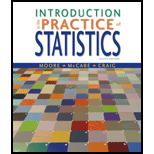
Introduction to the Practice of Statistics: w/CrunchIt/EESEE Access Card
8th Edition
ISBN: 9781464158933
Author: David S. Moore, George P. McCabe, Bruce A. Craig
Publisher: W. H. Freeman
expand_more
expand_more
format_list_bulleted
Question
Chapter 12.1, Problem 6UYK
(a)
To determine
To find: The critical value of
(b)
To determine
To Find: The critical value of
(c)
To determine
To Find: The critical value of
(d)
To determine
To explain: The properties of
Expert Solution & Answer
Want to see the full answer?
Check out a sample textbook solution
Students have asked these similar questions
19. (a) Define the joint distribution and joint distribution function of a bivariate ran-
dom variable.
(b) Define its marginal distributions and marginal distribution functions.
(c) Explain how to compute the marginal distribution functions from the joint
distribution function.
18. Define a bivariate random variable. Provide an
example.
6. (a) Let (, F, P) be a probability space. Explain when a subset of ?? is measurable
and why.
(b) Define a probability measure.
(c) Using the probability axioms, show that if AC B, then P(A) < P(B).
(d) Show that P(AUB) + P(A) + P(B) in general. Write down and prove the
formula for the probability of the union of two sets.
Chapter 12 Solutions
Introduction to the Practice of Statistics: w/CrunchIt/EESEE Access Card
Ch. 12.1 - Prob. 1UYKCh. 12.1 - Prob. 2UYKCh. 12.1 - Prob. 3UYKCh. 12.1 - Prob. 5UYKCh. 12.1 - Prob. 6UYKCh. 12.1 - Prob. 4UYKCh. 12.2 - Prob. 7UYKCh. 12.2 - Prob. 8UYKCh. 12 - Prob. 9ECh. 12 - Prob. 10E
Ch. 12 - Prob. 11ECh. 12 - Prob. 12ECh. 12 - Prob. 13ECh. 12 - Prob. 14ECh. 12 - Prob. 15ECh. 12 - Prob. 16ECh. 12 - Prob. 17ECh. 12 - Prob. 18ECh. 12 - Prob. 39ECh. 12 - Prob. 19ECh. 12 - Prob. 43ECh. 12 - Prob. 41ECh. 12 - Prob. 42ECh. 12 - Prob. 49ECh. 12 - Prob. 20ECh. 12 - Prob. 21ECh. 12 - Prob. 28ECh. 12 - Prob. 29ECh. 12 - Prob. 30ECh. 12 - Prob. 35ECh. 12 - Prob. 36ECh. 12 - Prob. 23ECh. 12 - Prob. 24ECh. 12 - Prob. 25ECh. 12 - Prob. 26ECh. 12 - Prob. 31ECh. 12 - Prob. 32ECh. 12 - Prob. 33ECh. 12 - Prob. 34ECh. 12 - Prob. 37ECh. 12 - Prob. 38ECh. 12 - Prob. 27ECh. 12 - Prob. 40ECh. 12 - Prob. 45ECh. 12 - Prob. 46ECh. 12 - Prob. 47ECh. 12 - Prob. 48ECh. 12 - Prob. 50ECh. 12 - Prob. 51ECh. 12 - Prob. 52ECh. 12 - Prob. 53ECh. 12 - Prob. 54ECh. 12 - Prob. 55ECh. 12 - Prob. 56ECh. 12 - Prob. 57ECh. 12 - Prob. 58ECh. 12 - Prob. 59ECh. 12 - Prob. 60ECh. 12 - Prob. 63ECh. 12 - Prob. 22ECh. 12 - Prob. 67ECh. 12 - Prob. 68ECh. 12 - Prob. 69ECh. 12 - Prob. 44ECh. 12 - Prob. 61ECh. 12 - Prob. 62ECh. 12 - Prob. 64ECh. 12 - Prob. 65ECh. 12 - Prob. 66E
Knowledge Booster
Similar questions
- 21. Prove that: {(a, b), - sa≤barrow_forward10. (a) Define the independence of sets A, B, C. (b) Provide an example where A, B, C are pairwise independent but not mutually independent. (c) Give an example where P(AnBnC) = P(A)P(B)P(C), but the sets are not pairwise independent.arrow_forward23. State Bayes' formula. Jaching R. Machine.arrow_forward(d) Show that A, and A' are tail events.arrow_forward11. (a) Define the (mathematical and conceptual) definition of conditional probability P(A|B). (b) Explain the product law in conditional probability. (c) Explain the relation between independence and the conditional probability of two sets.arrow_forward12. (a) Explain tail events and the tail o-field. Give an example. (b) State (without proof) the Kolmogorov zero-one law.arrow_forward24. A factory produces items from two machines: Machine A and Machine B. Machine A produces 60% of the total items, while Machine B produces 40%. The probability that an item produced by Machine A is defective is P(D|A)=0.03. The probability that an item produced by Machine B is defective is P(D|B) = 0.05. (a) What is the probability that a randomly selected product be defective, P(D)? (b) If a randomly selected item from the production line is defective, calculate the probability that it was produced by Machine A, P(A|D).arrow_forward13. Let (, F, P) be a probability space and X a function from 2 to R. Explain when X is a random variable.arrow_forward(b) Prove that if ACBC (A), then (A)=(B).arrow_forwardarrow_back_iosSEE MORE QUESTIONSarrow_forward_ios
Recommended textbooks for you
 Glencoe Algebra 1, Student Edition, 9780079039897...AlgebraISBN:9780079039897Author:CarterPublisher:McGraw Hill
Glencoe Algebra 1, Student Edition, 9780079039897...AlgebraISBN:9780079039897Author:CarterPublisher:McGraw Hill Functions and Change: A Modeling Approach to Coll...AlgebraISBN:9781337111348Author:Bruce Crauder, Benny Evans, Alan NoellPublisher:Cengage Learning
Functions and Change: A Modeling Approach to Coll...AlgebraISBN:9781337111348Author:Bruce Crauder, Benny Evans, Alan NoellPublisher:Cengage Learning

Glencoe Algebra 1, Student Edition, 9780079039897...
Algebra
ISBN:9780079039897
Author:Carter
Publisher:McGraw Hill

Functions and Change: A Modeling Approach to Coll...
Algebra
ISBN:9781337111348
Author:Bruce Crauder, Benny Evans, Alan Noell
Publisher:Cengage Learning